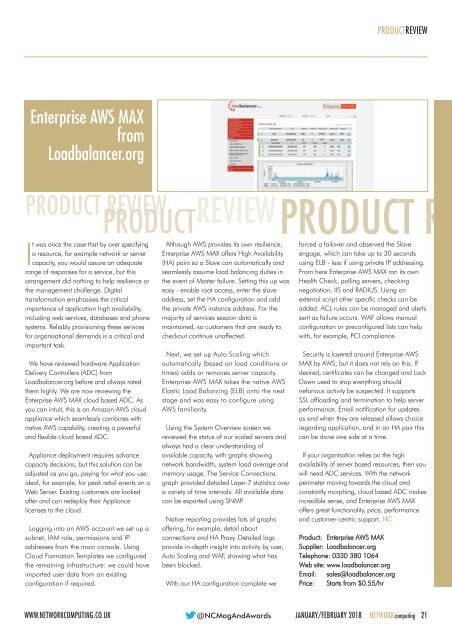NC1801
Create successful ePaper yourself
Turn your PDF publications into a flip-book with our unique Google optimized e-Paper software.
PRODUCTREVIEW<br />
Enterprise AWS MAX<br />
from<br />
Loadbalancer.org<br />
PRODUCT REVIEW<br />
PRODUCT<br />
REVIEWPRODUCT RE<br />
It was once the case that by over specifying<br />
a resource, for example network or server<br />
capacity, you would assure an adequate<br />
range of responses for a service, but this<br />
arrangement did nothing to help resilience or<br />
the management challenge. Digital<br />
transformation emphasises the critical<br />
importance of application high availability,<br />
including web services, databases and phone<br />
systems. Reliably provisioning these services<br />
for organisational demands is a critical and<br />
important task.<br />
We have reviewed hardware Application<br />
Delivery Controllers (ADC) from<br />
Loadbalancer.org before and always rated<br />
them highly. We are now reviewing the<br />
Enterprise AWS MAX cloud based ADC. As<br />
you can intuit, this is an Amazon AWS cloud<br />
appliance which seamlessly combines with<br />
native AWS capability, creating a powerful<br />
and flexible cloud based ADC.<br />
Appliance deployment requires advance<br />
capacity decisions, but this solution can be<br />
adjusted as you go, paying for what you use:<br />
ideal, for example, for peak retail events on a<br />
Web Server. Existing customers are looked<br />
after and can redeploy their Appliance<br />
licenses to the cloud.<br />
Logging into an AWS account we set up a<br />
subnet, IAM role, permissions and IP<br />
addresses from the main console. Using<br />
Cloud Formation Templates we configured<br />
the remaining infrastructure: we could have<br />
imported user data from an existing<br />
configuration if required.<br />
Although AWS provides its own resilience,<br />
Enterprise AWS MAX offers High Availability<br />
(HA) pairs so a Slave can automatically and<br />
seamlessly assume load balancing duties in<br />
the event of Master failure. Setting this up was<br />
easy - enable root access, enter the slave<br />
address, set the HA configuration and add<br />
the private AWS instance address. For the<br />
majority of services session data is<br />
maintained, so customers that are ready to<br />
checkout continue unaffected.<br />
Next, we set up Auto Scaling which<br />
automatically (based on load conditions or<br />
times) adds or removes server capacity.<br />
Enterprise AWS MAX takes the native AWS<br />
Elastic Load Balancing (ELB) onto the next<br />
stage and was easy to configure using<br />
AWS familiarity.<br />
Using the System Overview screen we<br />
reviewed the status of our scaled servers and<br />
always had a clear understanding of<br />
available capacity, with graphs showing<br />
network bandwidth, system load average and<br />
memory usage. The Service Connections<br />
graph provided detailed Layer-7 statistics over<br />
a variety of time intervals. All available data<br />
can be exported using SNMP.<br />
Native reporting provides lots of graphs<br />
offering, for example, detail about<br />
connections and HA Proxy. Detailed logs<br />
provide in-depth insight into activity by user,<br />
Auto Scaling and WAF, showing what has<br />
been blocked.<br />
With our HA configuration complete we<br />
forced a failover and observed the Slave<br />
engage, which can take up to 30 seconds<br />
using ELB - less if using private IP addressing.<br />
From here Enterprise AWS MAX ran its own<br />
Health Check, polling servers, checking<br />
negotiation, IIS and RADIUS. Using an<br />
external script other specific checks can be<br />
added. ACL rules can be managed and alerts<br />
sent as failure occurs. WAF allows manual<br />
configuration or preconfigured lists can help<br />
with, for example, PCI compliance.<br />
Security is layered around Enterprise AWS<br />
MAX by AWS, but it does not rely on this. If<br />
desired, certificates can be changed and Lock<br />
Down used to stop everything should<br />
nefarious activity be suspected. It supports<br />
SSL offloading and termination to help server<br />
performance. Email notification for updates<br />
as and when they are released allows choice<br />
regarding application, and in an HA pair this<br />
can be done one side at a time.<br />
If your organisation relies on the high<br />
availability of server based resources, then you<br />
will need ADC services. With the network<br />
perimeter moving towards the cloud and<br />
constantly morphing, cloud based ADC makes<br />
incredible sense, and Enterprise AWS MAX<br />
offers great functionality, price, performance<br />
and customer-centric support. NC<br />
Product: Enterprise AWS MAX<br />
Supplier: Loadbalancer.org<br />
Telephone: 0330 380 1064<br />
Web site: www.loadbalancer.org<br />
Email: sales@loadbalancer.org<br />
Price: Starts from $0.55/hr<br />
WWW.NETWORKCOMPUTING.CO.UK @NCMagAndAwards JANUARY/FEBRUARY 2018 NETWORKcomputing 21

















